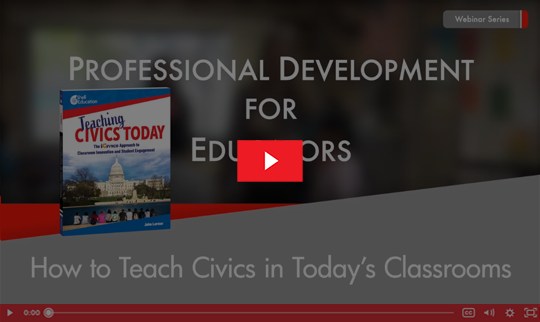The Problem
Americans don’t know enough about how our government works, or the principles upon which our constitutional democracy is built. They don’t understand the important role they play as citizens in a democracy. And they aren’t motivated to become active citizens.
But as Barack Obama said, “Democracy was never meant to be transactional—you give me your vote; I make everything better. It requires an active and informed citizenry.”
A Solution: More and Better Civic Education
Creating an “active and informed citizenry” is a tall order, and the challenge can’t be met only with more and better civic education in school—but it can help.
In the elementary grades, civics, and history/social studies generally, have taken a back seat to literacy and STEM in recent decades. Those subjects are, of course, important, and there’s only so much time in the school day. But civics can fit on teachers’ plates, too, with the right approach and resources.
In middle and high school, the issue is a little different. Students still have a social studies class as part of their daily schedule. This usually means history, except for occasional electives and perhaps a one-semester government/civics class in high school. Unfortunately, though, when students are asked in surveys which subject is the most boring, they often say it’s history or social studies. No wonder they soon forget most of what was covered!
I see two solutions to these issues. The first solution is teaching civics in elementary school whenever possible, as a standalone subject. But also remember you can find ways to include civics lessons when students are studying history, building literacy skills, and learning to be “citizens” of their classroom. The second solution is teaching civics (and history) in a more engaging way, whether in elementary or secondary school. This means active, not passive learning.
Seven Strategies for Teaching Civics
Let’s explore some of the ways these goals can be accomplished with these seven tips and ideas for teaching civics.
Include Civics Lessons
When students study state, U.S., or world history, include civics lessons. For example, discuss the debate over government power and individual rights in the Constitutional Convention in 1787. Point out how ancient civilizations governed themselves and draw connections to the present. Find local and state connections to wider events and developments, such as the civil rights movement. (A note to science and math teachers: you could find connections to civics too!)
Connect with Literacy
Include civics in literacy lessons, and literacy in civics lessons. Today’s ELA standards include many connections to civics. For example, the standards call for citing textual evidence when writing or speaking; conducting research projects; participating effectively in conversations with others; and making presentations with media. Civics topics can be used for all of these. Students can read books and informational text about civics and history. Primary source documents, such as the Declaration of Independence, can provide opportunities for building close reading skills.

Don’t Focus on “Factoids”
Focus on important knowledge, concepts, and skills, not the “factoids.” In the quiz at the beginning of this post, question #3 is an example of the latter. It’s not all that important to know how many Constitutional amendments there are—so I’d quibble with including that item on the citizenship test. Memorizing that kind of information is what makes civics class boring. Questions #1 and #2 on the quiz, on the other hand, are about the deeper concepts that students could actively explore, not simply memorize: the rule of law and how power is divided between the federal and state governments.
Use Project-Based Learning
Project-based learning (PBL) is a perfect fit for civics. It’s active, in-depth, and meaningful to students. Just so we’re clear on what PBL is and is not, I’m not talking about a poster showing the powers of the three branches of government or a slide presentation about a United States president that a student has researched. PBL is a process, not simply the creation of an artifact, as shown on the diagram below.

(Source: Teaching Civics Today, page 115)
Here are three examples of PBL projects for civics:
- Students determine which level of government (local, state, or federal) has the power to do something about an issue they care about, then contact the appropriate people or agency by writing persuasive letters.
- Students create a public awareness-raising campaign about an issue or problem in their community or the wider world, using publicly shared videos, art, speeches, and/or social media.
- Students create podcasts about concepts such as freedom, rights, or democracy by interviewing community members and experts.
Teach Civil Discourse
Civics teachers can help by building the habits and skills young people will need for reasoned, evidence-based, respectful discussion of civics-related issues. Two excellent resources for information on teaching civil discourse can be found at Facing History and Ourselves and Learning for Justice. Consider having discussions, not debates, where the point is not to “win,” but to understand.
Teach Information Literacy
In these times of online information overload and misinformation, this is an essential competency citizens must build. Civic education can help students build a firm foundation for finding the truth from trustworthy sources and developing evidence-based arguments. Some of the best resources for teaching information/media literacy are from iCivics, Learning for Justice, and the Digital Inquiry Group.
Build Classroom Citizenship
Civics can be taught in many ways, not just through formal lessons and activities like the above. Build democratic citizenship in the classroom. The classroom culture a teacher creates can teach students how to listen to and talk with each other respectfully, participate in decision-making, the values of cooperation, compromise and sharing—all the things kindergarten teachers do in circle time on the rug! Creating the culture can begin by co-creating with students a list of classroom norms or agreements that promote civic values.
Civics teachers have an essential job to do! Equip and motivate students to become an active and informed citizenry by teaching civics, beginning with the seven strategies outlined in this article.
Here are the answers to the quiz, and here’s to more and better civic education!
- c
- a
- d

